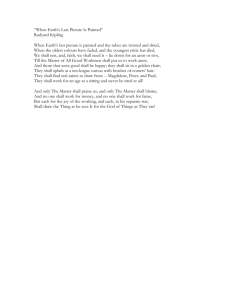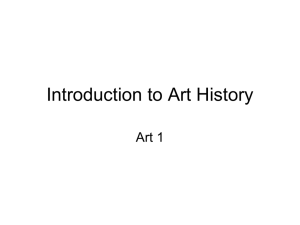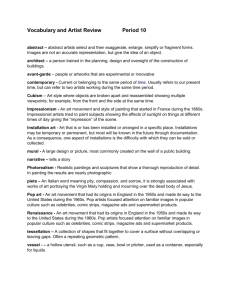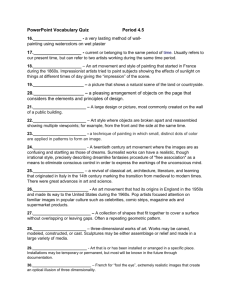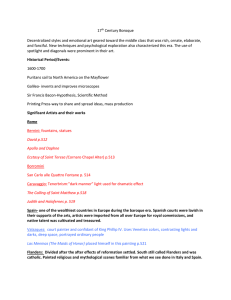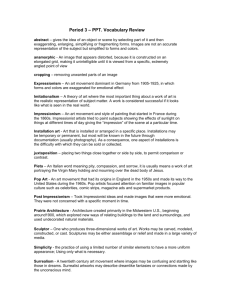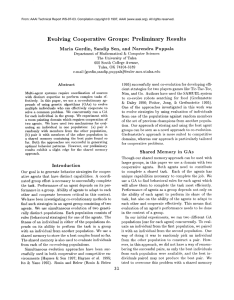art history - Mrs. Russell's Visual Art classes
advertisement
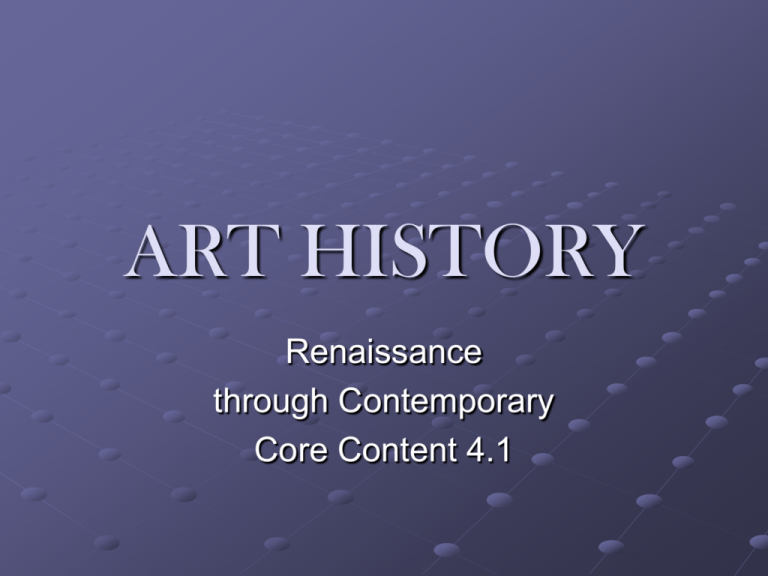
ART HISTORY Renaissance through Contemporary Core Content 4.1 Renaissance Period 1400-1600 Reconciles Christian faith and reason. Promotes ‘rebirth’ of the classical ideal (of ancient Greece and Rome) Allows new freedom of thought. Humanism – emphasis on intellect, education, the importance of the thinking breathing human being! Renaissance Artists begin to blend religious and secular (non-religious) subjects Artists developed linear perspective that created a greater look of space/depth Key artists: Michelangelo, da Vinci, Donatello, Raphael (The Ninja Turtles) Michelangelo He was a sculptor, painter, architect He preferred sculpting Famous sculptures: Pieta (Mary holding dying Jesus), David Famous Paintings: the frescos of the Sistine Chapel He blended religion and Humanistic elements in his works Michelangelo Pieta Michelangelo - David Sistine Chapel Leonardo da Vinci Painter, sculptor, architect, engineer, inventor, mathematician, astronomer… the Renaissance Man Famous paintings: Mona Lisa, Last Supper Use of sfumato da Vinci The Baroque Period Rejects the limits of the previous styles Restores the power of monarchy and church. Art is characterized by excess, ornamentation, contrasts, energy, tensions Artists used dramatic lighting that created a spotlight effect on their subjects – chiaroscuro or tenebroso The Baroque Period Chiaroscuro – use of light and shade to create a 3-D effect Tenebroso – Italian meaning “in a dark manner”. Artists used contrast of theatrical lighting against dark shadows in their work Subjects included both religious and secular pieces – rise in personal portraits and landscapes in the Netherlands Rembrandt van Rijn Dutch painter Master of chiaroscuro Painted over 65 selfportraits Subjects had ‘light’ on face and dark background Rembrandt van Rijn Caravaggio Led a rebellious life. Prone to drinking and fights… carried over into artwork. The church often refused his paintings because they were too violent or showed saints behaving as common people (ex Jesus in a Roman bar) Master of tenebroso Caravaggio’s work Neo-Classical Period Reacts to the excesses of the monarchy and the ornamentation of the Baroque Returns to order, reason and structural clarity (of the Classic Greek and Roman styles – hence the name ‘Neo-Classicism’) Artists incorporated clean, clear lines in both painting and architecture – composers similarly placed emphasis on clear prominent melody lines… Jaques-Louis David French painter Painted the aristocracy and then Napoleon during the Revolution Depicted Napoleon in best manner – brave, and regal – art used as propaganda to depict strong leader Subjects are simple with clear lines, very orderly appearance Jaques-Louis David Thomas Jefferson American President Traveled through Europe and brought back architecture of Greece and Rome Blended styles for formal government buildings – known as Federalist Style Very orderly, symmetrical, dignified Roman arches, Greek pediments Monticello – TJ’s home Farmington home in Louisville Thomas Jefferson Monticello – Jefferson’s home Used triangular Greek pediment, Roman arches and dome structure Orderly, clear lines, logic of design apparent Thomas Jefferson influence Romantic Period 1760-1870 Revolts against neo-classical order and reason Returns to nature/imagination: freedom, emotion, sentimentality, interest in the exotic and the supernatural Romantics painted emotional scenes with loose brush strokes and brilliant color Paintings became more personal, emotional Scenes were more dynamic and interesting than in real life hence “Romanticising” them Francisco Goya Spanish Romantic artist – went through 3 ‘phases’ of artwork Royal painter – earned a respectable living painting the Spanish royal family Political Commentary – He witnessed Napoleon’s troops invade Spain and painted the harsh reality of warfare Mental Illness (Black Period) – he drew nightmarish, monster-like figures – some on the walls of his home. Goya -- Royal Family Goya – Politics John Constable British Romantic painter Concerned with forces of nature so painted landscapes Had the incredible ability to capture the warmth of sunlight, the coldness in shadows and the motion of clouds His strong brush strokes and interest on the effects of light paved the way for the Impressionists John Constable John Constable Realism 1820-1920 Speaks the truth. Finds beauty in the commonplace (everyday scenes). Focuses on the Industrial revolution and the conditions of the working class Moved away from royalty as subject matter and painted peasants, working men and women Found the ordinary to be interesting Gustave Courbet Painted everyday workers – very controversial His “The Stone Breakers” and Burial at Ornans” were reviled – who would want a painting of people working or at a funeral !? Gustave Courbet - Realism Eduard Manet He transitioned between Realism and Impressionism He went from crisp clean lines to blurred edges His subjects remained common – people on a picnic or waiting for a train Eduard Manet Impressionism 1850-1920 Started as a rebellion against Realism Artists tried to capture a moment in time - a snapshot (Camera invented at this time) Tried to show the effects of light and atmospheric conditions Often painted the same scene at different times of the day to capture the colors Were the first artists to paint outside because of the inventions of portable easels and paint in tubes Claude Monet Quintessential impressionist Known for ‘waterlily’ series, Japanese Bridge Painted haystacks, Rouen Cathedral repeatedly but with differing color schemes Claude Monet Waterlilies - Monet Mary Cassatt American, female painter Studied in France with Degas, Monet, Manet, etc – The ‘great’ impressionists Her subjects usually included domestic scenes of women and children Used soft pastel colors or bright, happy hues in her work Influenced by Japanese work in using dark outlines of subjects Mary Cassatt Auguste Rodin Impressionist sculptor Tried to capture a moment in time Sculpted movement and action in his figures Created ‘fragmentary’ sculptures at the end of his career Auguste Rodin Auguste Rodin
